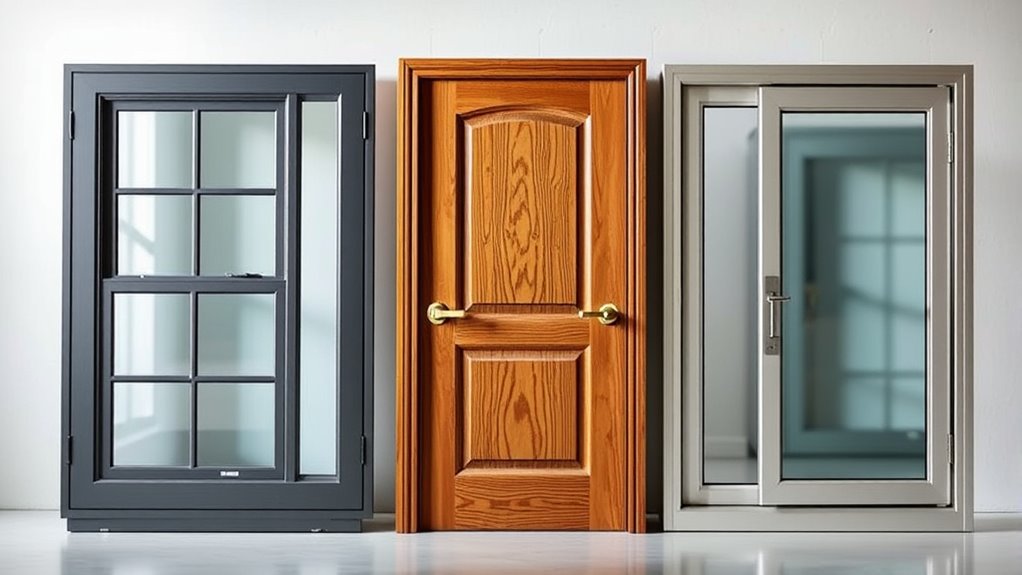Window and door packages made from steel, wood, and aluminum each offer unique strengths. Steel provides exceptional durability, security, and strength for larger sash sizes but requires thermal breaks and corrosion protection. Wood offers natural beauty, high insulation, and customization but needs regular maintenance to prevent rot and moisture damage. Aluminum balances strength with lightweight design, featuring corrosion resistance and slim profiles for modern aesthetics. Exploring these options further will help you choose the best materials for your specific climate and design needs.
Key Takeaways
- Steel packages offer high strength, security, and durability, suitable for large sash sizes and extreme climates but need thermal breaks and corrosion protection.
- Wood packages provide natural aesthetics, excellent insulation, and customization options, but require regular maintenance and protection against moisture and pests.
- Aluminum packages are lightweight, corrosion-resistant, and feature slim profiles for modern designs, with improved thermal breaks for better energy efficiency.
- Material selection depends on climate, security needs, aesthetic preferences, and maintenance capacity, with each material offering distinct advantages and limitations.
- Proper installation and ongoing maintenance are essential for maximizing performance and longevity across all material types.

Window and door packages offer an integrated solution for homeowners and builders seeking to enhance energy efficiency, security, and aesthetic appeal. When selecting a package, understanding the specific characteristics of steel, wood, and aluminum is essential to optimize performance and meet project requirements. Each material presents distinct advantages and limitations, which influence installation choices, maintenance routines, and long-term durability.
Steel frames provide exceptional strength and durability, allowing for larger sash sizes without compromising structural integrity. They are inherently resistant to warping, cracking, and swelling, making them suitable for climates with extreme temperature fluctuations and high moisture levels. The high strength-to-weight ratio enables thinner profiles, maximizing glass area and natural light ingress. Steel’s inherent security features—such as resistance to forced entry—are crucial for residential and commercial applications where security is a priority. However, steel requires proper insulation strategies, such as thermal breaks, to mitigate heat conduction and improve energy efficiency. Without adequate thermal breaks, steel frames may cause thermal bridging, leading to increased energy costs. Maintenance involves preventing corrosion through protective coatings and periodic inspections, especially in coastal environments where salt exposure accelerates deterioration.
Wood window and door packages offer a natural aesthetic and high insulative properties but demand rigorous maintenance to sustain performance. Wood’s inherent thermal insulation surpasses that of metal alternatives, reducing heat transfer and contributing to energy efficiency. Its versatility allows for intricate design options and customization, aligning with traditional or craftsman architectural styles. However, wood is susceptible to moisture absorption, which can lead to swelling, rot, and insect infestation if not properly treated and maintained. Protective finishes, sealants, and regular inspections are necessary to prevent deterioration and ensure longevity. Proper installation with moisture barriers and proper flashing is critical to avoid water infiltration and structural damage. While maintenance-intensive, well-maintained wood packages can provide decades of service, blending natural beauty with durability.
Aluminum window and door packages balance strength and weight, making them suitable for large openings and modern architectural designs. Aluminum frames boast high resistance to corrosion, especially when anodized or coated, making them ideal for coastal and humid environments. Their slim profiles maximize glass surface area, enhancing natural light and views. Aluminum’s low maintenance requirements—primarily cleaning and periodic coating inspections—make it a practical choice for commercial and residential applications. Thermal performance, historically a concern with aluminum frames, has been substantially improved through the integration of thermal breaks, which reduce heat transfer and improve energy efficiency. The lightweight nature of aluminum also simplifies installation processes and reduces framing costs. Nonetheless, aluminum’s high thermal conductivity necessitates careful consideration of insulation strategies to meet energy standards.
Frequently Asked Questions
What Are the Cost Differences Between Steel, Wood, and Aluminum Packages?
Steel packages typically cost more upfront due to durability and strength, but they offer lower maintenance over time. Wood packages usually have a higher initial price because of craftsmanship and materials, yet they provide excellent insulation. Aluminum packages tend to be the most affordable initially, with lower maintenance costs, but they may have higher long-term energy costs. Your choice depends on budget, durability needs, and energy efficiency priorities.
How Do Maintenance Requirements Vary Among the Three Materials?
You might think steel, wood, and aluminum require similar maintenance, but they don’t. Steel needs periodic corrosion protection, especially in humid environments. Wood demands regular sealing, staining, or painting to prevent rot and insect damage. Aluminum is low-maintenance; it resists corrosion and only needs occasional cleaning. Proper upkeep guarantees longevity, but your choice depends on how much effort you’re willing to invest in maintenance.
Which Material Offers the Best Insulation for Energy Efficiency?
You’ll find that wood offers the best insulation among steel, wood, and aluminum, thanks to its natural thermal properties. It has higher R-values, reducing heat transfer and improving energy efficiency. Steel and aluminum conduct heat more readily, leading to greater energy loss. Hence, if insulation is your priority, wood frames provide superior thermal performance, helping to lower heating and cooling costs over time.
Are Custom Sizes Available for Each Type of Window and Door?
Yes, custom sizes are available for each type of window and door. You can specify exact dimensions to guarantee a perfect fit for your project. Manufacturers typically offer customization options for steel, wood, and aluminum frames, allowing you to select sizes that meet your design specifications and structural requirements. Confirm with your supplier about available options and lead times to ensure your custom sizes are manufactured accurately and delivered promptly.
How Do Durability and Weather Resistance Compare Across Materials?
Think of each material as a fortress against the elements. Steel offers unmatched strength and excellent weather resistance, making it highly durable in harsh climates. Aluminum resists corrosion well and is lightweight, providing good weather resistance but can conduct heat, affecting insulation. Wood, while naturally beautiful and insulative, requires regular maintenance to withstand moisture and weathering. Your choice depends on balancing durability, weather resistance, and maintenance needs for your specific environment.
Conclusion
Choosing the right window and door package depends on your specific needs and preferences. Steel offers durability, wood provides classic aesthetics, and aluminum combines strength with lightweight design. Did you know that aluminum windows can reduce heat transfer by up to 60% compared to traditional options? This statistic underscores the importance of material selection for energy efficiency. Carefully evaluate your priorities—security, style, or efficiency—to guarantee your investment enhances your property’s value and performance.









